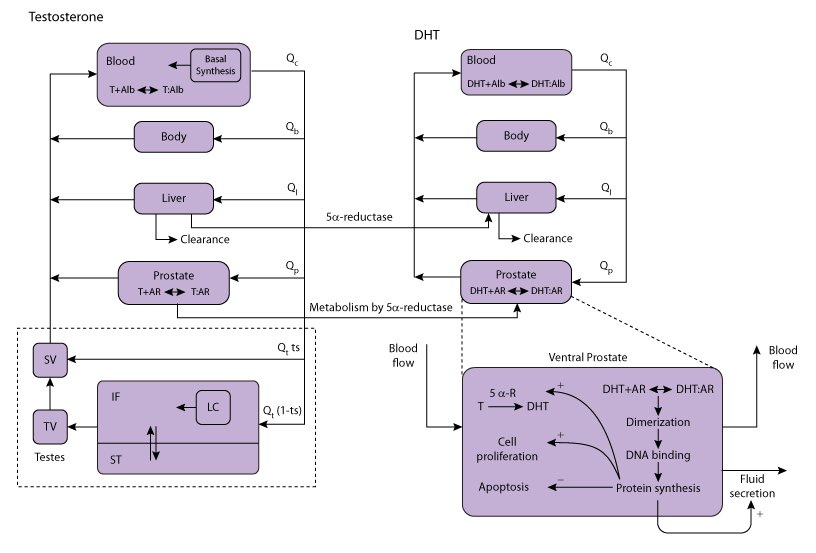Potter, Zager, Barton, 2006
Model Status
This CellML version of the model has been checked in COR and PCEnv. The units have been checked and are correct and are consistent. The model runs in PCEnv, COR and Opencell but does not recreate the published results. Equation 29 has been fixed with the help of the model author.
Model Structure
Abstract: The testicular-hypothalamic-pituitary axis regulates male reproductive system functions. Understanding these regulatory mechanisms is important for assessing the reproductive effects of environmental and pharmaceutical androgenic and antiandrogenic compounds. A mathematical model for the dynamics of androgenic synthesis, transport, metabolism, and regulation of the adult rodent ventral prostate was developed on the basis of a model by Barton and Anderson (1997). The model describes the systemic and local kinetics of testosterone (T), 5{alpha}-dihydrotestosterone (DHT), and luteinizing hormone (LH), with metabolism of T to DHT by 5{alpha}-reductase in liver and prostate. Also included are feedback loops for the positive regulation of T synthesis by LH and negative regulation of LH by T and DHT. The model simulates maintenance of the prostate as a function of hormone concentrations and androgen receptor (AR)-mediated signal transduction. The regulatory processes involved in prostate size and function include cell proliferation, apoptosis, fluid production, and 5{alpha}-reductase activity. Each process is controlled through the occupancy of a representative gene by androgen-AR dimers. The model simulates prostate dynamics for intact, castrated, and intravenous T-injected rats. After calibration, the model accurately captures the castration-induced regression of the prostate compared with experimental data that show that the prostate regresses to ~17 and 5% of its intact weight at 14 and 30 days postcastration, respectively. The model also accurately predicts serum T and AR levels following castration compared with data. This model provides a framework for quantifying the kinetics and effects of environmental and pharmaceutical endocrine active compounds on the prostate.
 |
| Model schema for testosterone (T) and 5alpha-dihydrotestosterone (DHT) kinetics. Arrows represent blood flow between tissue compartments, substrate metabolism, and clearance (as labelled). T synthesis occurs in the blood and in testicular Leydig cells (LC), with androgen binding to albumin in the blood and to androgen receptor (AR) in the prostate. The testes compartment can be further broken down into spermatic cord venous blood (SV), testicular venous blood (TV), interstitial fluid (IF), and seminiferous tubules (ST). Androgenic regulation in the prostate is highlighted. T is converted to DHT, and either T or DHT can bind to the AR and form homogeneous or heterogeneous dimers (this diagram is only showing DHT binding, not T binding). AR-mediated DNA transcription leads to enhanced cell proliferation and conversion of T to DHT, and inhibition of cell apoptosis. |
The complete original paper reference is cited below:
Mathematical model for the androgenic regulation of the prostate in intact and castrated adult male rats, Laura K. Potter, Michael G. Zager, and Hugh A. Barton, 2006, American Journal of Physiology: Endocrinology and Metabolism, volume 291, E952-E964. PubMed ID: 16757547

